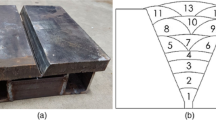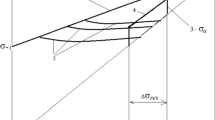Abstract
This research examines the use of vibratory methods to reduce residual stresses in structures. The main objective of this work is to seek a better knowing of the mechanism of the reduction of residual stresses of materials undergoing cyclic loading. Experiments have demonstrated that residual stresses can be largely relieved through vibratory stress relief (VSR) treatment. The factors that influence the reduction of residual stresses need to be understood to effectively apply the process. A mathematical model based on plasticity theorem with linear kinematic hardening is generated to explain the mechanism of reduction of residual stresses of materials experiencing cyclic loading. The numerical results from the mathematical model and the analytical results with existing experimental data for rectangular cross-section beams showed a similar trend.
Similar content being viewed by others
References
Dawson, R., and Moffat, D.G., “Vibratory Stress Relief: A Fundamental Study of Its Effectiveness,” Journal of Engineering Materials and Technology 102(2): 169–176 (1980).
McGoldrick, R.T., and Saunders, H.E., “Some Experiments in Stress Relieving Castings and Welded Structures by Vibration,” Journal of the American Society of Naval Engineers 55:589–609 (1943).
Moore, H.F., “A Study of Residual Stresses and Size Effect and a Study of the Effect of Repeated Stresses on Residual Stresses Due to Shot Peening of Two Steels,” Proceedings of the Society for Experimental Stress Analysis 2:170–177 (1944).
Lokshin, I.K., “Vibration Treatment and Dimensional Stabilization of Castings,” Russian Castings Production 7:454–456 (1965).
Yang, Y.P., “Understanding of Vibration Stress Relief with Computation Modeling,” Journal of Materials Engineering and Performance 18:856–862 (2009).
Kwofie, S., Plasticity Model for Simulation, Description and Evaluation of Vibratory Stress Relief, Kwame Nkrumah University of Science and Technology, Kumasi, Ghana, pp. 154–161 (2009).
Zhao, X.C., Zhang, Y.D., and Ma, Y.J., “Finite Element Analysis of Vibratory Stress Relief Process,” Applied Mechanics and Materials 88–89:623–627 (2011).
Fu, J., Huang, X., and Xu, L., “Numerical Simulation for Technological Parameters of Vibratory Stress Relief in Large Welding Structures,” Applied Mechanics and Materials 217–219:2046–2050 (2012).
Duan, N., Li, X., Du, W., and Dou, X., “Simulation Research on Relieving Welding Residual Stress by Vibratory Stress Relief Technology,” Advanced Materials Research 652–654:2343–2346 (2013).
Yin, H.C., Zhang, G.Y., and Yan, H.Y., “Relieving Residual Stresses of the Welding Workpiece in the Steel Structure by Vibratory Stress Relief,” Gongcheng Lixue/Engineering Mechanics 26:188–191 (2009).
Jurcius, A., Valiulis, A.V., Cernasejus, O., Kurzydlowski, K.J., Jaskiewicz, A., and Lech-Grega, M., “Influence of Vibratory Stress Relief on Residual Stresses in Weldments and Mechanical Properties of Structural Steel Joint,” Journal of Vibroengineering 12:133–141 (2010).
Liao, K., Wu, Y.X., and Guo, J.K., “Application of VSR Technique in Stress Reduction of Aluminum Alloy Thick Plate and Its Limitation,” Zhendong yu Chongji/Journal of Vibration and Shock 31:70–73 (2012).
Khan, M.B., and Iqbal, T., “Vibratory Stress Relief in D-406 Aerospace Alloy,” TMS Annual Meeting, San Francisco, CA, pp. 807–814 (2009).
Djuric, D., Vallant, R., Kerschbaumer, K., and Enzinger, N., “Vibration Stress Relief Treatment of Welded High-Strength Martensitic Steel,” Welding in the World 55:86–93 (2011).
Wang, J.S., Hsieh, C.C., Lin, C.M., Kuo, C.W., and Wu, W., “Texture Evolution and Residual Stress Relaxation in a Cold-Rolled Al-Mg-Si-Cu Alloy Using Vibratory Stress Relief Technique,” Metallurgical and Materials Transactions A: Physical Metallurgy and Materials Science 44:806–818 (2013).
He, W., Gu, B., Zheng, J., and Shen, R., “Research on High-Frequency Vibratory Stress Relief of Small Cr12MoV Quenched Specimens,” Applied Mechanics and Materials 157–158:1157–1161 (2011).
Meng, J., Zhang, C., Tong, Y., Wang, C., Jin, Y., and Qi, W., “Research and Design of the Control System for Vibratory Stress Relief Based on Virtual Instrument,” Key Engineering Materials 500:291–296 (2011).
Sedek, P., and Weglowski, M.S., “Application of Mechanical Vibration in the Machine Building Technology,” Key Engineering Materials 504–506:1383–1388 (2012).
Wang, J.S., Kuo, C.W., Hsieh, C.C., Liao, H.C., and Wu, W., “The Effects of Waveform in Residual Stress Relief by Vibration Technique,” Proceedings of the 9th International ASM Conference on Trends in Welding Research, Chicago, IL, pp. 427–431 (2013).
Florea, R.S., Hubbard, C.R., Solanki, K.N., Bammann, D.J., Whittington, W.R., and Marin, E.B., “Quantifying Residual Stresses in Resistance Spot Welding of 6061-T6 Aluminum Alloy Sheets Via Neutron Diffraction Measurements,” Journal of Materials Processing Technology 212:2358–2370 (2012).
Taggart, R., Merchant, H.C., and Bodre, R.A., “Vibration Stress Relief in Single Crystals,” Proceedings of ASME Conference on Productive Applications of Mechanical Vibrations 3, Phoenix, AZ, November 14–19, pp. 59–74 (1982).
Frankel, J., Abbate, A., and Scholz, W., “The Effect of Residual Stresses on Hardness Measurements,” Experimental Mechanics 33:164–168 (1993).
Chen, X.Q., Niu, H., Li, D., and Li, Y., “Intrinsic Correlation Between Hardness and Elasticity in Polycrystalline Materials and Bulk Metallic Glasses,” Intermetallics 19:1275–1281 (2011).
Yang, D.Y., and Guo, R., “Experimental Study on Modulus and Hardness of Ettringit,” Experimental Techniques 38:6–12 (2014).
Bush, A.F., and Kromer, F.J., “Residual Stresses in a Shaft after Weld Repair and Subsequent Stress Relief,” Experimental Techniques 5:6–12 (1981).
Author information
Authors and Affiliations
Corresponding author
Rights and permissions
About this article
Cite this article
Vardanjani, M.J., Ghayour, M. & Homami, R.M. Analysis of the Vibrational Stress Relief for Reducing the Residual Stresses Caused by Machining. Exp Tech 40, 705–713 (2016). https://doi.org/10.1007/s40799-016-0071-3
Published:
Issue Date:
DOI: https://doi.org/10.1007/s40799-016-0071-3




